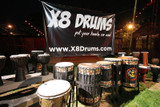History of the Cajon
The cajon is believed to have originated in Peru when the African slaves, brought to Peru from Angola, began using fruit crates as percussion instruments. Displaced from their homeland, the African slaves substituted cod shipping crates for their native drums.
In Cuba, small dresser drawers were used for the same purpose. The instrument was refined and became an important part of Cuban and Peruvian music. Early usage of the Peruvian cajon was to accompany Tondero and Zamacueca (old version of Marinera) dances. Tapping knuckles on wooden tables may be considered a predecessor to the cajon.
Three quarter inch pine or other white wood was generally used for five sides of the box. A thin sheet of plywood was nailed on as the sixth side and acted as the head or striking surface. The top edges were often left unattached and could be slapped against the box. A sound hole was cut in the side opposing the head. The player sat on the box striking the head between his legs. The modern cajon drum has several screws at the top for adjusting percussive timbre and may sport rubber feet. Some versions may also have several vertically stretched cords pressed against the tapa for a buzz like effect or tone.
Today, the cajon is heard extensively in Andean, Cuban, and Flamenco music. It's steadily gaining popularity in all types of contemporary music and has become a favorite for "unplugged" sessions and is often used to accompany the acoustic guitar.
Recent Posts
-
Integrating Djun Djun into Modern Music: A Guide for Musicians
What is Djun Djun in modern music? Djun Djun, a type of drum originating from West Africa, is comm …21st Apr 2024 -
Incorporating the Thumb Piano into Modern Music Production
Introduction to the Thumb Piano The thumb piano, also known as the Kalimba or Mbira, is a small …15th Apr 2024 -
The Top 5 Djembes for Beginners: A Buyer's Guide
What is a Djembe? A Djembe is a type of drum originating from West Africa, traditionally made from …13th Apr 2024



